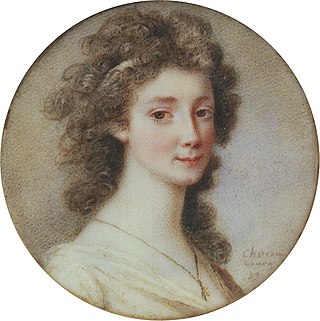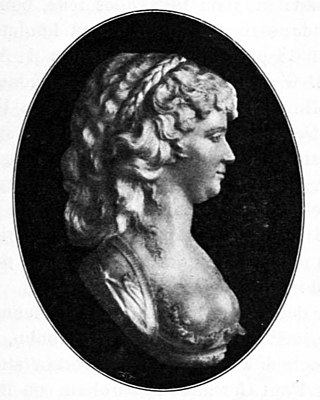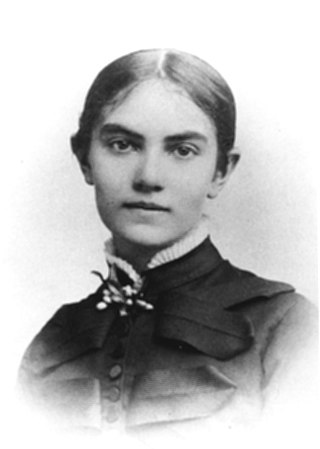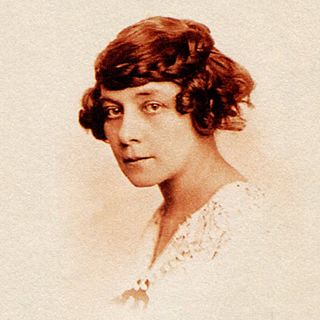
Princess Ingeborg of Denmark, was a Princess of Sweden by marriage to Prince Carl, Duke of Västergötland.

Countess Eva Sophie Piper, née Eva Sophie von Fersen, was a Swedish countess and lady in waiting. She was the daughter of count Axel von Fersen the Elder and Hedvig Catharina von Fersen and the sister of Axel von Fersen the Younger, Hedvig Eleonora von Fersen and Fabian von Fersen (1762–1818). She is foremost known for her close friendship with Queen Hedvig Elizabeth Charlotte, who dedicated her famous diary to her.

Fredrica Löf, also known as Fredrique Löwen, was a Swedish stage actress. She was the first female star at the newly founded national stage Royal Dramatic Theatre, which was founded the year of her debut.

Maria Kristina Franck was a Swedish actress and drama teacher. She was a member of the pioneer generation of the Royal Dramatic Theatre, and belonged to the first stars of the theater. She has been referred to as her country's first native dramatic tragedienne. She was the principal of the Royal Dramatic Training Academy from 1819 to 1823. During her last years on stage, she was known under her name as married, Ruckman.

Lea Fredrika Ahlborn was a Swedish artist and medallist. She was a member of the Royal Swedish Academy of Arts and the first woman to be appointed royal printmaker. The position of royal printmaker was counted as a public office, and thereby made her the first female official or civil servant in Sweden.

Sofia Franziska Stading was a Swedish opera singer of German origin. She is referred to as one of the more notable opera singers in Sweden during the Gustavian era. She was a Hovsångare and member of the Royal Swedish Academy of Music from 1788.
Margareta i Kumla also known as the Sibyl of Kumla, or Kumlapigan, , was a Swedish visionary, who claimed to be possessed. She became the target of pilgrimages when claiming to be the channel of the words of the angels.

Augusta Lundin was a Swedish fashion designer. She is considered to be the first international Swedish haute couture fashion designer as well as the first well known fashion designer in Sweden.

Runsa is an estate located in Upplands Väsby Municipality in Stockholm County, Sweden. It the site of the ruins of an ancient fortification and of Runsa Manor which was built in the middle of the 17th century.

Margareta Slots or Margareta Cabiljau was the royal mistress of king Gustav II Adolf of Sweden and the mother of his illegitimate son Gustav of Vasaborg.

Astrid Sampe was a Swedish textile designer who for a large part of her professional life was affiliated with the textile department at Nordiska Kompaniet but also worked for several other textile producers.

Astrid "Astri" Linnéa Matilda Taube, née Bergman was a Swedish sculptor and artist known for her child portraits and sculptures in public venues. She was married to Swedish singer and songwriter Evert Taube.

Karin Larsson, née Bergöö, was a Swedish artist and designer who collaborated with her husband, Carl Larsson, as well as being often depicted in his paintings.

Esther Gehlin née Henriques (1892–1949) was a Danish-Swedish painter of Jewish descent whose water colours and oils include still lifes, interiors, portraits and landscapes. From 1922, she and her artist husband Hugo Gehlin settled in the Swedish town of Helsingborg where local artists and writers frequently gathered in their home. In the 1940s, she created textile appliqués inspired by early Christian art.

Anna Marie-Louise Petrus Lyttkens née Petersson (1886–1949) was a Swedish sculptor, graphic artist, designer and dancer. She is remembered in particular for the pewter and cast iron works with the lion motif she designed in the mid-1920s for Svenskt Tenn, some of which are still produced today. Petrus also contributed to the design of the Swedish pavilion for the 1925 Paris Exhibition.

Maria (Maja) Sjöström (1868–1961) was a prominent Swedish textile artist from the 1890s to the 1930s. In particular, she designed intricate interior decorations for the new Stockholm City Hall. These included enormous silk tapestries which were woven at the Luigi Bevilacqua Textile Company in Venice. Following the opening of the city hall in 1923, Sjöström moved to Rome where she spent the rest of her life, ultimately in poverty, dismissed by the Swedes for her belief in Mussolini. Her reputation was however restored in the 2000s.

Carin Helena Wästberg (1859–1942) was a Swedish textile artist who helped to revive interest in textile arts in Sweden inspired by local peasant techniques and the developments she had seen in England. As its leader from 1904, she developed the Friends of Handicraft association into the country's top textile producer, creating a new production technique in collaboration with Maja Sjöström. Under her leadership, the association produced many notable works for public buildings in Stockholm, including those she herself designed in 1915 for the Stockholm Court House.

Vera Amalia Märta Nilsson (1888–1979) was a Swedish painter and a peace activist. One of Sweden's most prominent Expressionists, she is remembered in particular for her paintings of children, including her daughter Ginga, and for her landscapes, often scenes of Öland where she spent her summers. Her anti-war sentiments are vividly expressed in Penning conta liv, painted during the Spanish Civil War in 1939. In the 1960s, she painted works protesting nuclear war. Her work is represented in museums and galleries in Sweden and abroad, including Nationalmuseet and Moderna Museet in Stockholm.

Wilhelmina Wendt, commonly known as Tiddit, was a Swedish silversmith. She was the first woman in Sweden to be granted the title of "master silversmith". From the late 1920s, she designed trays, serving dishes, bowls, jugs and jewellery. In the mid 1940s, she settled in Perstorp where she combined her father's black insulation material "isolit" with her own thin silver designs, producing artefacts in what she called "silverisolit".

Sofia Gisberg (1854–1926) was a Swedish sculptor, textile artist and educator. From 1887, she taught at Tekniska Skolan, where she became director of women students until 1925, modernizing the teaching of textile arts. She is also remembered for designing the fountain in Vängåvan Park, Sundsvall, for her church textiles and for creating certificates for Nobel prizewinners. Examples of her work are in the collection of Stockholm's National Museum.




















